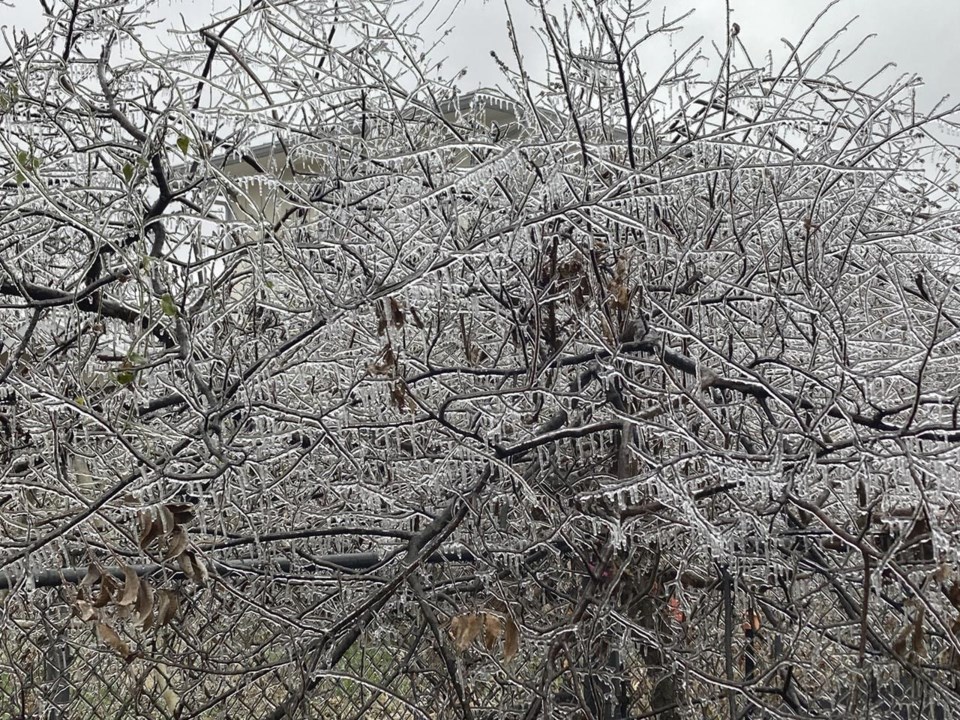AUSTIN, Texas (AP) — Thousands of frustrated Texans shivered in homes without power for a second day Thursday, most of them around booming Austin, and fading hopes of a quick fix stirred grim memories of a deadly 2021 blackout after an icy winter storm across the southern U.S.
The freeze has been blamed for at least 10 traffic deaths on slick roads this week in Texas, Arkansas and Oklahoma. And even as Texas finally began thawing Thursday, a new Artic front from Canada was headed toward the northern U.S. and threatening New England with potentially the coldest weather in decades. Wind chills could dive below minus 50 (minus 45 Celsius).
In Austin, city officials compared the damage from fallen trees and iced-over power lines to tornadoes as they came under mounting criticism for slow repairs and shifting timelines to restore power.
“We had hoped to make more progress today,“ said Jackie Sargent, general manager of Austin Energy. ”And that simply has not happened."
Across Texas more than 280,000 customers were without power Thursday night, down from 430,000 earlier in the day, according to PowerOutage.us. The failures were most widespread in Austin, where impatience was rising among 150,000 customers nearly two days after the electricity first went out, which for many also means no heat. Power failures have affected about 30% of customers in the city of nearly a million at any given time since Wednesday.
By Thursday night, Austin officials backtracked on early estimates that power would be fully restored by Friday evening, saying the extent of the damage was worse than originally calculated and that they could no longer predict when all the lights may come back on.
Allison Rizzolo, who lost power in Austin, told KEYE-TV that she wished there were more clarity from the city on what to do or expect.
“I get that there’s a fine line between preparedness and panic, but I wish they’d been more aggressive in their communications,” Rizzolo said.
For many Texans, it was the second time in three years that a February freeze — temperatures were in the 30s Thursday with wind chills below freezing — caused prolonged outages and uncertainty over when the lights would come back on.
Unlike the 2021 blackouts in Texas, when hundreds of people died after the state’s grid was pushed to the brink of total failure because of a lack of generation, the outages in Austin this time were largely the result of frozen equipment and ice-burdened trees and limbs falling on power lines. But the differences were little comfort to Austin residents and businesses that also lost power for days two years ago.
Among those still without power Thursday was the Central Texas Food Bank, according to Travis County Judge Andy Brown, the county's top elected official.
“They have 21 counties to serve. They've been down for at least three days now. There's a lot of need that they have,” Brown said.
School systems in the Dallas and Austin area, plus many in Oklahoma, Arkansas and Memphis, Tennessee, closed Thursday as snow, sleet and freezing rain continued to push through. In Austin, schools will not open until next week at the earliest.
Hundreds more flights were canceled again in Texas, although not as many as in previous days.
Airport crews battled ice to keep runways open. By Thursday morning, airlines had canceled more than 500 flights at Dallas-Fort Worth International Airport — more than a quarter of all flights scheduled for the day. Still, that was down from about 1,300 cancellations on Wednesday and more than 1,000 on Tuesday, according to FlightAware.com.
Dozens more flights were canceled at Dallas Love Field and Austin-Bergstrom International Airport.
Another wave of frigid weather in the U.S. is on the horizon, with an Arctic cold front expected to move from Canada into the northern Plains and Upper Midwest and sweep into the Northeast by Friday.
In a briefing Thursday with the federal Weather Prediction Center, New Englanders were warned that wind chills — the combined effect of wind and cold air on exposed skin — in the minus 50s “could be the coldest felt in decades.”
The strong winds and cold air will create wind chills “rarely seen in northern and eastern Maine,” according to an advisory from the National Weather Service office in Caribou, Maine.
Jay Broccolo, director of weather operations at an observatory on New Hampshire’s Mount Washington — which for decades held the world record for the fastest wind gust — said Thursday that wind speeds could top 100 mph (160 kph).
“We take safety really seriously in the higher summits," Broccolo said, “and this weekend’s forecast is looking pretty gnarly, even for our standards.”
___
Miller reported from Oklahoma City. Associated Press Airlines Writer Dave Koenig in Dallas and writers Kathy McCormack in Concord, N.H., and Jeff Martin in Atlanta contributed to this report.
___
For more AP weather coverage: https://apnews.com/hub/weather
Paul J. Weber And Ken Miller, The Associated Press


